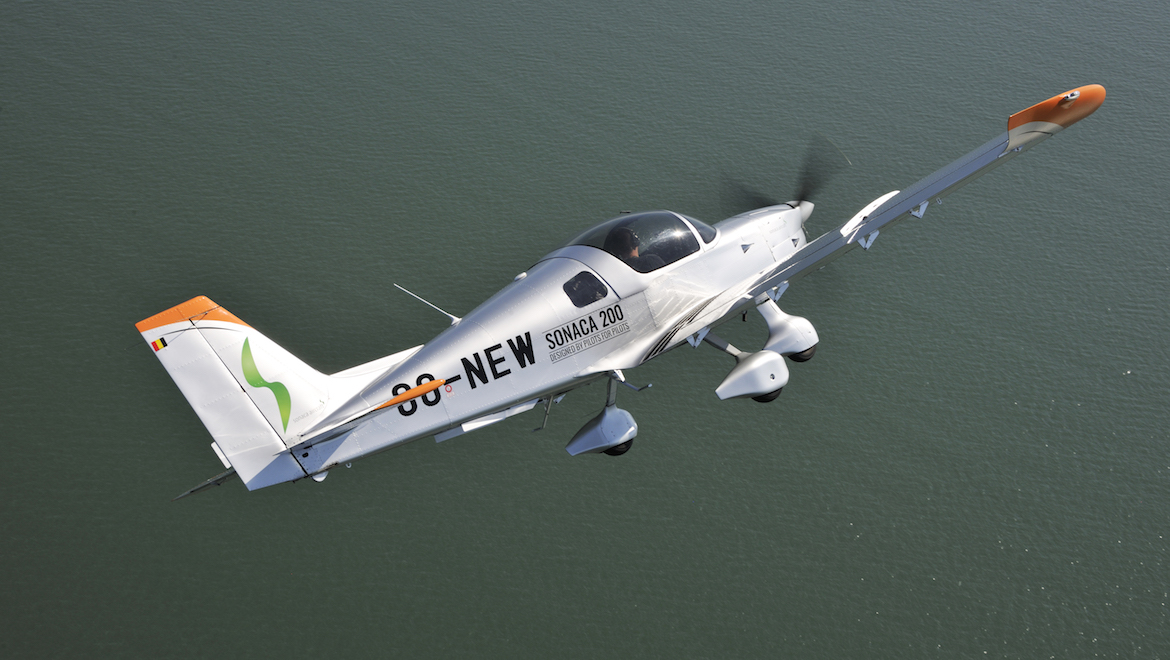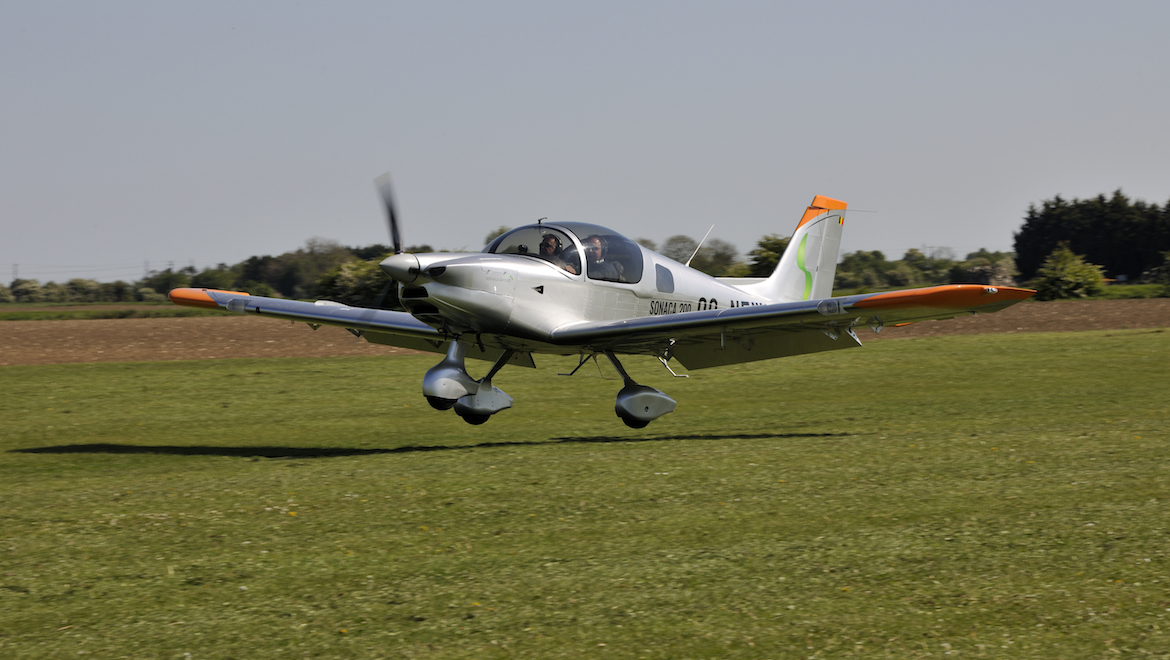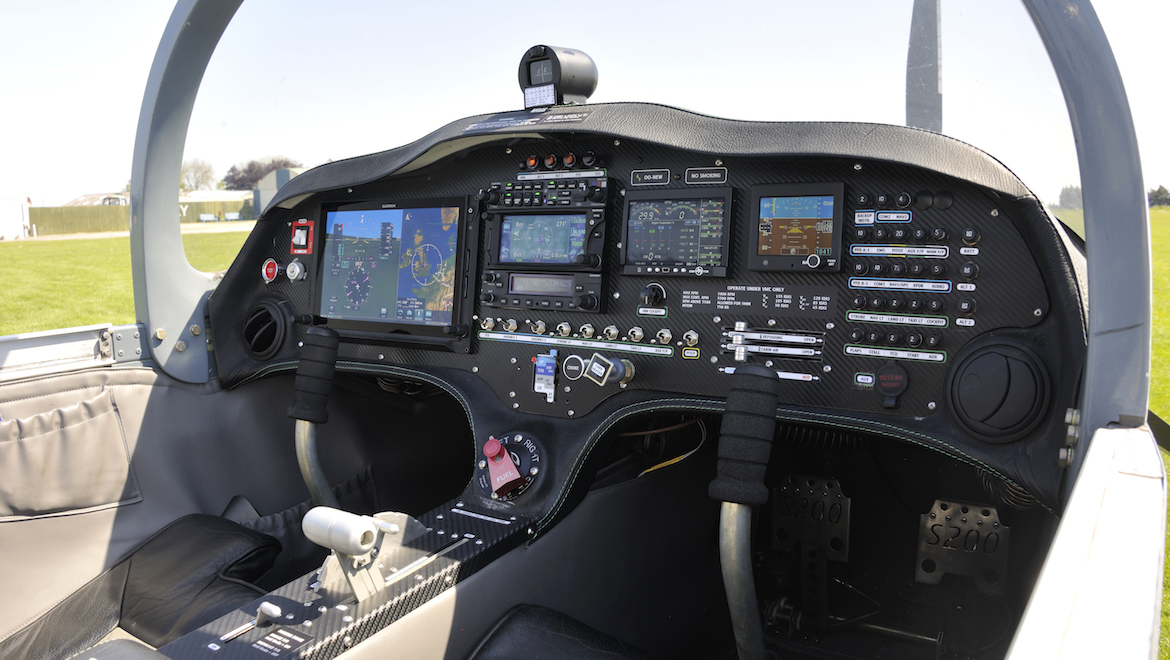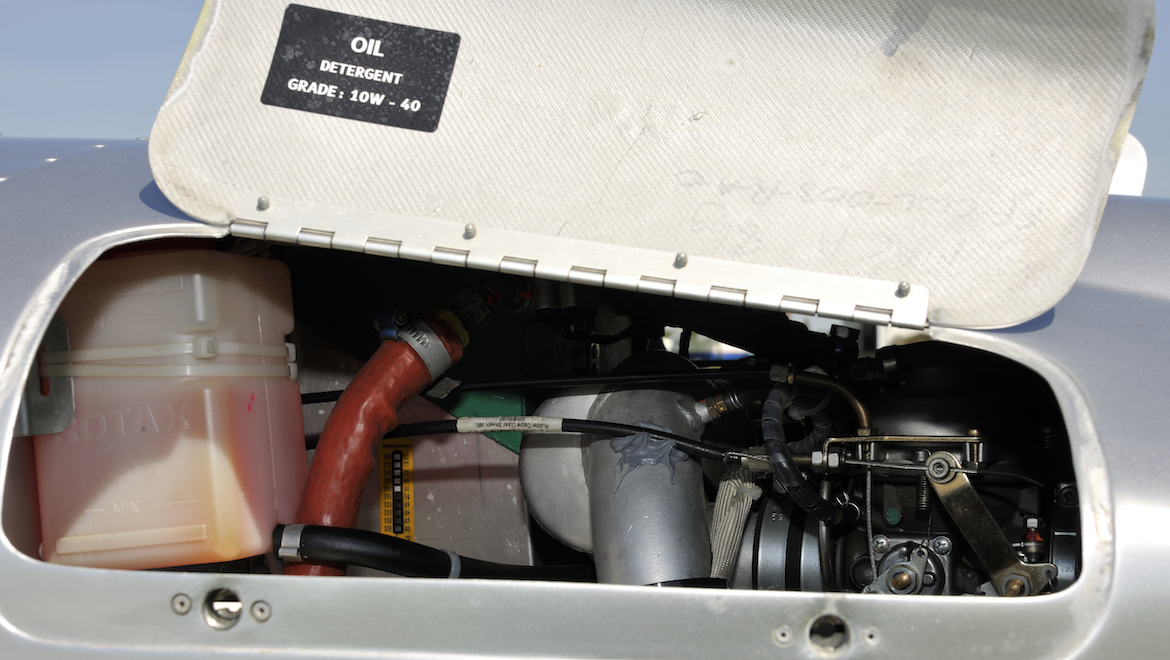This flight test of the Sonaca 200 Trainer Pro from United Kingdom-based journalist Dave Unwin is from the October 2019 edition of Australian Aviation.

Some mornings are just made for flying, and as I ease into a very tight echelon port with the cameraship, this morning is clearly one of those!
The day had started with a degree of déjà vu. I’d met up with photographer Keith on a stunning late spring morning at the lovely grass airfield of Fenland in Lincolnshire, and from a distance the test aircraft looked very much like the TAF Sling we’d flown last year.
In fact, the test aircraft was a Sonaca 200 Trainer Pro, the latest – and loaded – iteration of the popular Belgian two-seater built by the huge industrial consortium of Sonaca Group in Namur, the capital of Wallonia.
Although it is undeniable that the Sonaca 200 bears more than a passing resemblance to the Sling Two, up close it soon becomes apparent that it is a very different machine. Whereas the South African Sling is primarily marketed as a kit plane, the 200 is a European Union Aviation Safety Agency (EASA)-approved, factory-built Very Light Aircraft (VLA). Consequently the Sonaca 200 has been extensively redesigned to meet the far more stringent regulations of EASA’s Certification Specification for VLAs (Amendment 1), or CS-VLA.
As for Australia, Sonaca says it has already approached the Civil Aviation Safety Authority (CASA) with a view to the Sonaca 200 obtaining CASA certification based on the EASA approvals.
The aircraft available in two versions, the “Trainer” and the “Trainer Pro”. The test aircraft is the latter version, and with its all-glass cockpit and fully integrated avionics it is intended for the burgeoning airline academy market.

Drawing closer I note the dorsal fillet, ventral strakes and large wing fences at approximately mid-span. These aerodynamic tweaks are to enhance spin recovery and improve aileron response near the stall respectively to ensure compliance with CS-VLA (Amendment 1), although most of the differences are actually under the skin.
Sonaca claims that about “80 per cent of the initial structure has been redesigned to meet market requirements on the one hand, and EASA certification requirements on the other. The main spars of the wing, the connection to the fuselage and the central spar have been redesigned and some aluminum alloys have been modified to take account of the aerodynamic loads, material fatigue as well as corrosion-related aspects.”
These alterations have increased the MAUW (maximum all-up weight) by 50kg to 750kg with a +4.4 “G” limit load factor, while other changes include strengthening the canopy arches, undercarriage, vertical and horizontal tail surfaces, installing a different propeller, and redesigning the instrumentation, brakes and fuel system.
It certainly looked very smart, while bare metal finish glowing gently in the spring sunshine vaguely reminded me of a mid-1950s USAF fighter.
Starting at the spinner, the three-blade DUC Flash-R prop is spun by a neatly-cowled 115hp (86kW) Rotax 914 UL turbocharged air/liquid-cooled flat-four. All the fuel is carried in a pair of 73-litre tanks, one in each wing root’s leading edge. The wide track/short wheelbase undercarriage consists of a steerable nosewheel (via the rudder pedals) which is suspended from a telescopic strut, and mainwheels fitted with hydraulic disc brakes and carried by a low-maintenance articulated aluminium-alloy arch on either side of the fuselage. This arrangement prevents deformation of the fuselage during a heavy landing – always a possibility for a hard-working trainer. All three wheels are closely spatted.
The ailerons and elevator are actuated by pushrods with cables for the rudder. Elevator trim is manually actuated while the large-span slotted flaps are electric. These have four positions; 0°, 10°, 20° and 30°. Each wing’s leading edge has dual LED landing/taxi lights built in near the tips, with position and strobe lights located below the slightly upswept winglets. There are ground adjustable trim tabs on the port aileron and rudder, while the stepped static port is interesting.
The monocoque fuselage is made primarily from aluminium as are the wings, flaps, ailerons, fin, elevator and rudder, with composites used for the tips, cowling and canopy frame. Overall, it looked robust, rugged and ready to work for a living. There’s a plethora of rivets and the skins seem quite thick, while well-designed quick-access hatches and jacking points are ideal for ease of maintenance. It not only looked modern but also new – and this is important. Most airline industry analysts are predicting a chronic shortage of pilots over the next 10 years, and it could be a boom time for the burgeoning airline academies. It must be quite disconcerting for a tyro airline pilot who has just borrowed a six-figure sum from the “Bank of Mum & Dad” to pay for their training, and on their first day they’re introduced to a machine that is – literally – older than their parents!
The 200 Trainer Pro version in particular is very much aimed at this potentially extremely lucrative market. As I was soon to discover, the avionics are comparable to those fitted to the aircraft students will fly later in their careers, while Sonaca has invested heavily in an advanced support platform which should ensure enhanced after-sales service. It’s also very nicely finished, which made the white cable ties securing the hydraulic lines to the main undercarriage arches even more incongruous.
The impression of a modern machine is reinforced on entering the cockpit. Access is good, although I wasn’t so keen on using the rear-ward sliding canopy to help pull myself up onto the wide non-slip wing root walkway. Just aft of the trailing edge are sensibly-sited streamlined footsteps, but I think possibly some sort of spring-loaded handle just below the canopy rail would be useful as well, as when you pull on the canopy there’s a considerable side-load.
Behind the seats is a big baggage bay that can take up to a very impressive 35kg. The seatbacks tip forward for easy access. I thought I’d examine the aircraft from an instructor’s perspective, and sit on the right. Settling on to the very comfortable seat I slide it forward (which simultaneously raises it up) and study the controls and instruments with considerable interest, as the panel would shame some older airliners. Unsurprisingly its “all glass”, as even the standby instrument (a Honeywell KI 300 which displays airspeed, attitude, altitude and slip/skid) is digital.

Directly in front of the pilot is a large Garmin G500TXI MFD. A “touchscreen”, it can be split several ways and is quite amazing. There’s a neat stack of Garmin avionics in the centre (GTN650 and GTX335), with a very comprehensive JPI EDM 900 engine monitoring unit on the right.
Beneath the avionics stack is a row of silver toggle switches for the electrical services. Although there’s a colour-coded line below them to link them to the colour-coded circuit breakers they’re slightly anonymous. Below these switches is the pre-selector type flap switch and plungers for the choke and carb heat, with the big Andair fuel selector in the section that joins the panel to the centre console.
This extends aft between the seats and carries a large T-handled throttle lever with a big elevator trim wheel to its left and the park brake behind. The throttle features a spring-loaded catch (like some jet’s afterburner selector), which must be raised to push the throttle over a detent and up to maximum power. With the throttle at the detent 100hp is produced, while full power is 115hp. One of the dual carburettors carries a throttle arm position sensor which measures the throttle’s position linearly from 0 per cent (idle) to full power. The TCU (Turbocharger Control Unit) uses throttle position, ambient pressure, airbox pressure/temperature, and engine rpm to actuate an electronically controlled waste gate to regulate boost pressure in the engine airbox. The TCU adds boost from the 108 per cent throttle position onward.

Of course, with any turbocharged engine care must be taken not to exceed boost pressure, so as well as the MAP display on the EMU (pressure is shown in both analogue and digital formats) the row of annunciator lights above the avionics stack includes both “TCU CAUTION” and “TCU WARN”.
From an ergonomic viewpoint it’s impressive. Adjustable seats and four-point harness – check. Different shapes for the carb heat and choke – check. Fuel selector pointing to the selected tank – check. Flap limiting speeds placarded next to the flap switch – check. Good use of colour-coding – check. Even the park brake was orientated correctly! However, as the choke and carb knobs are so close together there should be a guard over the choke. You only use it on start-up, but if a student inadvertently selected choke instead of carb heat on downwind the resultant “rich cut” could be awkward.
As there is no DV panel the canopy should have an intermediate stop to allow the aircraft to be flown with the canopy about a metre open in-flight. It does have excellent air vents; cabin heating and canopy demist (its almost car-like) but I still like to be able to see out if there’s – for example – oil all over the windscreen.
Plus, it’s just fun (and also cooler, both literally and metaphorically) to be able to fly around with the canopy at least partly open. Probably the biggest omission was the lack of stick-mounted electric pitch trim. Often, I’m against electric trim in small aeroplanes (and to be fair the big wheel between the seats is nicely geared and works well) but the tyro airline pilots will soon graduate to types with electric trim so why not introduce them to the concept from the start?

The 914 started smoothly. Taxiing is easy – there’s a fine field of view over and either side of the nose as the seats are set quite high, the nosewheel steers through the rudder pedals and differential braking can be used to tighten the turn.
Ambient conditions are slightly above ISA (Fenland is essentially at sea level but the OAT is +18ºC) while the wind is a gentle zephyr from the east. We have about half-fuel, so as those 70 litres weigh about 50kgs and we’re about 170 we’re still some 70kgs below the 750 MAUW, and the initial acceleration is good on the short, dry grass. Then I remember the detent, raise the catch and push the lever fully forward. There’s a positive push as the turbo cuts in. Suddenly we’ve got an extra 15 horses and the acceleration improves exponentially. The controls come alive almost immediately and the powerful rudder makes maintaining the centreline easy.
Having used about 400 metres of the grass runway the Sonaca skips into the sky and climbs away powerfully at about 750ft/min and the Vy of 70kt. The limiting speed for TO flap is usefully high at 105kts (some modern aircraft have ridiculously low flap limiting speeds) so there’s no rush to retract the flaps. As they retract the change in pitch trim is quite subtle. Bring the throttle back past the detent and we set off in pursuit
of the cameraship.
Almost as soon as the wheels left the ground the Sonaca 200 made a very positive impression, and continues to impress when we examine control and stability, cruise performance, stall characteristics and everything else on the flight test card.
Stalls power on or off and flaps up and down are all equally benign, with little to no tendency to drop a wing. Clean and with the throttle at idle the wing quit at around 50kts, while with full flap and some power the lowest indicated speed I saw was 42kts. From the stability perspective, stick-free, the lateral and longitudinal stability is positive. As for control, it is very good, with light, crisp ailerons, a nicely-balanced elevator and powerful rudder (although in fact only a small amount of rudder is necessary to keep the slip ball centred, as there is little adverse yaw). Essentially, it’s a stable aircraft with good controllability that is very nice to fly.
Cruising back towards Fenland at 3,000ft and a comfortable 5,000rpm gave an IAS of 100kts for a TAS of
106 and a fuel burn of 26-27lit/hr. Bump the throttle up to the METO of 5,500 increases the IAS to 112 (12 per cent), but the fuel flow goes up to about 34lit/hr, or an increase of roughly 25 per cent. Pull the power back to a more relaxed 4,800 and it’ll still produce a TAS of 100 while only burning 23lit/hr. At this power setting the range is quoted as over 550nm, with a 30-minute reserve. Pretty impressive.

It was such a lovely day I was reluctant to fly on instruments, but for the sake of completeness did get on the gauges for a few minutes. The large screen, well-defined horizon and synthetic vision would make it easy to fly in IMC. Indeed, the advent of the glass cockpit has made the entire instrument flying process exponentially easier than it used to be!
Back at Fenland, I’d kept the speed up into the circuit and appreciated the faster-than-normal flap limiting speeds. Even full flap is 85kts, while “Flap 2” (20º) is a generous 95kts. About 60kts “over the fence” felt about right. I did try one at 55kts, and wouldn’t recommend going much slower. For the final “touch ‘n’ go” I deliberately left the flaps down and didn’t use the turbo, and it still coped OK. Overall, I was very favourably impressed.

I’ve flown some pretty poor handling aircraft over the years, and (just as you do with an older car or motorbike) after a few hours have learnt to compensate for excessively heavy ailerons, an overly light elevator or a poorly geared trimmer. No such compensation is required when flying the Sonaca 200.
It is extremely well sorted. And that’s a very important point when you think that it is designed to be a trainer. Other significant advantages that would appeal to a flight school are that it can be used
for both basic and advanced training (it can be stalled and spun, or flown down an ILS with equal ease) and of course the engine typically burns around 20 litres an hour, making it considerably cheaper to run than many “legacy” trainers.
Of course, it would also make an excellent tourer for the discerning (albeit well-heeled) private owner, so you may be wondering why there wasn’t an autopilot fitted. The answer is simply because during the early stages of flight training the flight schools don’t want their students using an autopilot, and none have specified an autopilot as part of the equipment. However – and particularly when touring, an autopilot can be very useful and will be standard equipment on the IFR version currently under development.
What didn’t I like? Well, it is undeniable that the test aircraft is very expensive – in fact it is the most expensive Rotax-powered two-seater I’ve ever flown, and I’ve flown quite a few!
To be fair most (but not all) of those were kit planes, and this is a factory-built EASA VLA (the analogue version is around 31,000 cheaper). There’s going to be literally 10s of thousands of young pilots seeking an ATPL over the next 20 years, and they’ll have to train in an EASA/CASA-approved aeroplane.
Sonaca are pitching the 200 Trainer Pro firmly at that market.
VIDEO: A look at the Sonaca 200 during its flight test program from the manufacturer’s YouTube channel.
This story first appeared in the October 2019 edition of Australian Aviation.













